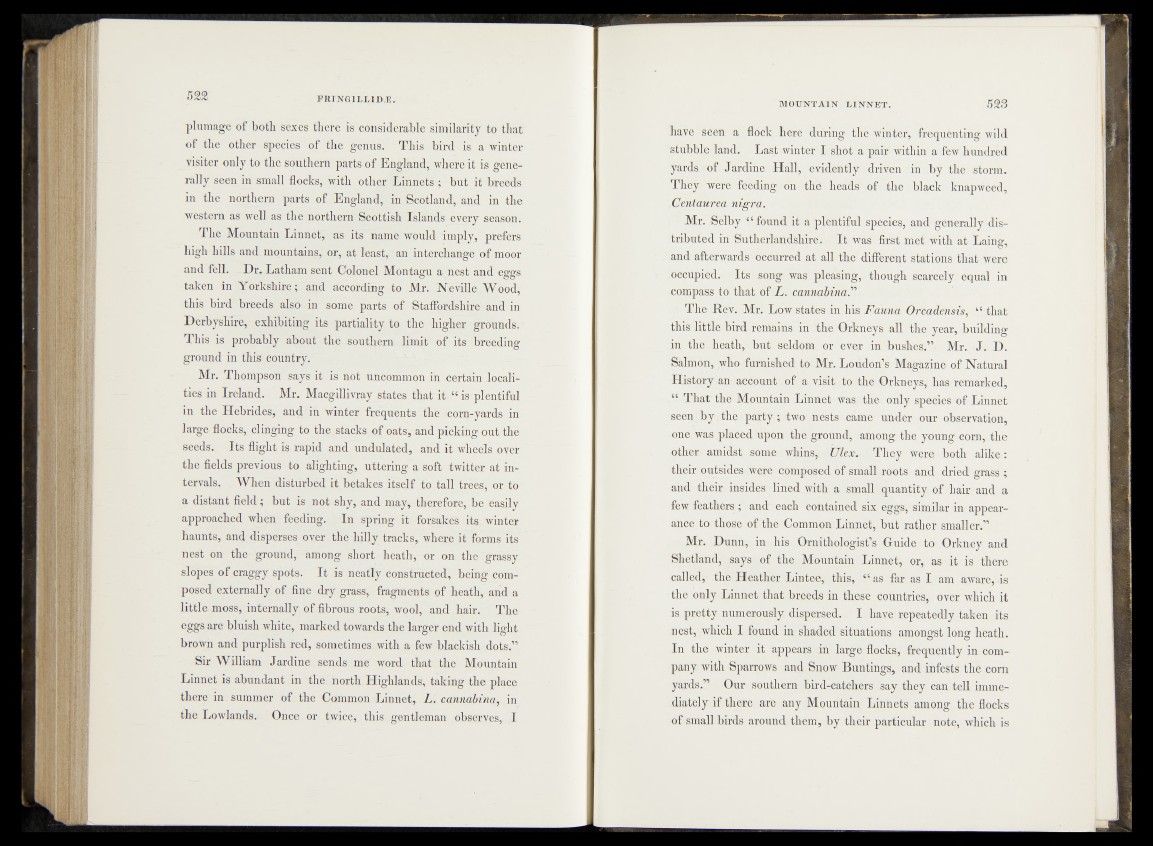
plumage of both sexes there is considerable similarity to that
of the other species of the genus. This bird is a winter
visiter only to the southern parts of England, where it is generally
seen in small flocks, with other Linnets ; but it breeds
in the northern parts of England, in Scotland, and in the
western as well as the northern Scottish Islands every season.
The Mountain Linnet, as its name would imply, prefers
high hills and mountains, or, at least, an interchange of moor
and fell. Dr. Latham sent Colonel Montagu a nest and eggs
taken in Yorkshire; and according to Mr. Neville Wood,
this bird breeds also in some parts of Staffordshire and in
Derbyshire, exhibiting its partiality to the higher grounds.
This is probably about the southern limit of its breeding
ground in this country.
Mr. Thompson says it is not uncommon in certain localities
in Ireland. Mr. Macgillivray states that it “ is plentiful
in the Hebrides, and in winter frequents the corn-yards in
large flocks, clinging to the stacks of oats, and picking out the
seeds. Its flight is rapid and undulated, and it wheels over
the fields previous to alighting, uttering a soft twitter at intervals.
When disturbed it betakes itself to tall trees, or to
a distant field; but is not shy, and may, therefore, be easily
approached when feeding. In spring it forsakes its winter
haunts, and disperses over the hilly tracks, where it forms its
nest on the ground, among short heath, or on the grassy
slopes of craggy spots. It is neatly constructed, being composed
externally of fine dry grass, fragments of heath, and a
little moss, internally of fibrous roots, wool, and hair. The
eggs are bluish white, marked towards the larger end with light
brown and purplish red, sometimes with a few blackish dots.”
Sir William Jardine sends me word that the Mountain
Linnet is abundant in the north Highlands, taking the place
there in summer of the Common Linnet, L. cannabina, in
the Lowlands. Once or twice, this gentleman observes, I
have seen a flock here during the winter, frequenting wild
stubble land. Last winter I shot a pair within a few hundred
yards of Jardine Hall, evidently driven in by the storm.
They were feeding on the heads of the black knapweed,
Centaurea nigra.
Mr. Selby “ found it a plentiful species, and generally distributed
in Sutherlandshire. It was first met with at Lainu,
and afterwards occurred at all the different stations that were
occupied. Its song was pleasing, though scarcely equal in
compass to that of L. cannabina.”
The Rev. Mr. Low states in his Fauna Orcadensis, “ that
this little bird remains in the Orkneys all the year, building
in the heath, but seldom or ever in bushes.” Mr. J. D.
Salmon, who furnished to Mr. Loudon’s Magazine of Natural
History an account of a visit to the Orkneys, has remarked,
“ That the Mountain Linnet was the only species of Linnet
seen by the party ; two nests came under our observation,
one was placed upon the ground, among the young corn, the
other amidst some whins, Ulex. They were both alike:
their outsides were composed of small roots and dried grass ;
and their insides lined with a small quantity of hair and a
few feathers ; and each contained six eggs, similar in appearance
to those of the Common Linnet, but rather smaller.”
Mr. Dunn, in his Ornithologist’s Guide to Orkney and
Shetland, says of the Mountain Linnet, or, as it is there
called, the Heather Lintee, this, “ as far as I am aware, is
the only Linnet that breeds in these countries, over which it
is pretty numerously dispersed. I have repeatedly taken its
nest, which I found in shaded situations amongst long heath.
In the winter it appears in large flocks, frequently in company
with Sparrows and Snow Buntings, and infests the corn
yards.” Our southern bird-catchers say they can tell immediately
if there are any Mountain Linnets among the flocks
of small birds around them, by their particular note, which is